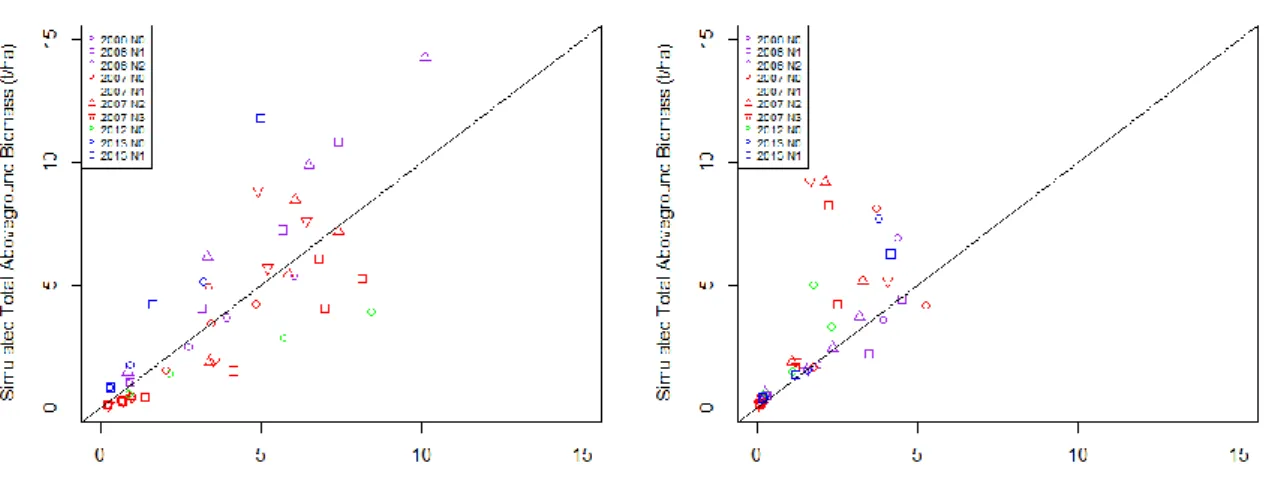HAL Id: hal-02565235
https://hal.umontpellier.fr/hal-02565235
Submitted on 13 May 2020HAL is a multi-disciplinary open access archive for the deposit and dissemination of sci-entific research documents, whether they are pub-lished or not. The documents may come from teaching and research institutions in France or abroad, or from public or private research centers.
L’archive ouverte pluridisciplinaire HAL, est destinée au dépôt et à la diffusion de documents scientifiques de niveau recherche, publiés ou non, émanant des établissements d’enseignement et de recherche français ou étrangers, des laboratoires publics ou privés.
Calibration and Evaluation of the STICS Intercrop
Model for Two Cereal-Legume Mixtures
Kirsten Paff, Sebastian Munz, Remi Vezy, Noémie Gaudio, Laurent
Bedoussac, Eric Justes
To cite this version:
Kirsten Paff, Sebastian Munz, Remi Vezy, Noémie Gaudio, Laurent Bedoussac, et al.. Calibration and Evaluation of the STICS Intercrop Model for Two Cereal-Legume Mixtures. ICROPM 2020 - Crop Modelling for the future, Feb 2020, Montpellier, France. �hal-02565235�
Calibration and Evaluation of the STICS Intercrop Model for Two Cereal-Legume Mixtures
Kirsten Paff1,2, Sebastian Munz3, Rémi Vezy4, Noémie Gaudio5, Laurent Bedoussac5, Éric Justes1,2,6 1INRA, UMR SYSTEM, F-34398 Montpellier, France, email: kirsten.paff@inra.fr
2SYSTEM, Univ Montpellier, CIRAD, INRA, IRD, Montpellier SupAgro, Montpellier, France
3Institute of Crop Science, University of Hohenheim, 70599 Stuttgart, Germany 4 CIRAD, UMR AMAP, F-34398 Montpellier, France
5 INRA, UMR AGIR, 31326 Castanet-Tolosan, France 6 CIRAD, PERSYST Department, 34398 Montpellier, France
Mots clés : Intensification écologique ; modèle de culture ; Pois ; Orge ; Blé dur Introduction
STICS is a soil-crop model capable of simulating crops in succession (Brisson et al., 2003).
Intercropping occurs when multiple species are grown simultaneously on the same field. There has been a growing interest in adapting this traditional technique for modern agriculture as a way of ecological intensification, especially for combining leguminous and cereal crops in order to reduce N inputs and potential environmental damage through N losses. Intercropping adds complexity to the system by adding inter-species competition. Crop models are useful tools for analyzing complex systems, as they allow the user far more control over individual variables than is possible in field experiments. A first version of the STICS intercrop model was created by Brisson et al. (2004) and was recently improved by Vezy et al. (2020). The aim of this study was to calibrate and evaluate this improved STICS-Intercrop model by simulating a winter and a spring intercrop mixture: durum wheat-winter pea and barley-spring pea.
Materials and Methods
The data set used for modelling comprised of four years of wheat (Triticum turgidum L.) and pea (Pisum
sativum L.) field data from Auzeville, France with multiple levels of nitrogen fertilizer, and four years
of barley (Hordeum vulgare L.) and pea field data from Angers, France (Corre-Hellou, 2005), which in some years included two levels of nitrogen fertilizer and two different plant densities of the intercrops. The sole crop trials were used for calibration and the intercrop trials for evaluation, except for a subset of intercrop data that was used to calibrate the parameters unique to the intercrop model. The assumption was that parameters common to both sole and intercropping, such as plant-soil interactions and phenology, would be the same for both. The optimization method used for calibration was based on Wallach et al. (2011). The parameters were broken down into 15 groups (16 for pea to include nitrogen fixation) for calibration, each corresponding to a different process.
Results and Discussion
The root mean square error (RMSE) for shoot biomass was 1.92 t/ha for winter pea and 1.37 t/ha for durum wheat. The RMSE for grain yield was 1.84 t/ha for spring pea and 1.15 t/ha for barley. Overall the model captured the dominancy of one species quite well, however the accuracy has to be increased. The phenology and height were correctly simulated. Some of the discrepancies could be due to biological stresses that STICS does not capture. The modelling efficiency is likely to improve because the model calibration process is still ongoing, especially for the pea-wheat simulations. Conclusions
The intercrop version of the STICS model was recently improved. An automatic calibration was performed in this study using two different crop mixtures, several years and multiple nitrogen
treatments to assess the capacity of the model to simulate these complex systems. The model performed reasonably well considering the wide range of conditions on which it was calibrated. STICS intercrop could be a useful tool for better understanding the processes and their interaction for this management practice.
Acknowledgments
This work was funded by the ReMIX project, a Research and Innovation project from the EU's Horizon 2020 Program. Special thanks to Nadine Brisson for beginning the work on the STICS intercrop model. We also thank Marie Launay, Dominique Ripoche, and Patrice Lecharpentier for their work on the model.
(a) (b)
Figure 1: Simulated versus observed in season total aboveground biomass for wheat (a) and pea (b) grown in intercrop with each other at Auzeville, France.
Références bibliographiques
Brisson N, Bussiere F, Ozier-Lafontaine H, Tournebize R, Sinoquet H (2004) Adaptation of the crop model STICS to intercropping. Theoretical basis and parameterisation. Agronomie, 24(6-7): 409-421.
Brisson N et al. (2003) An overview of the crop model STICS. European Journal of Agronomy, 18(3-4): 309-332.
Corre-Hellou G. 2005. Acquisition de l’azote dans des associations pois-orge (Pisum sativum L.– Hordeum vulgare L.) en relation avec le fonctionnement du peuplement. PhD thesis, Université d’Angers.
Vezy R et al. (2020) Implementation of new formalisms in STICS for intercropping modeling, iCROPM, Montpellier, France.
Wallach D et al. (2011) A package of parameter estimation methods and implementation for the STICS crop-soil model. Environmental Modelling & Software, 26(4): 386-394.
